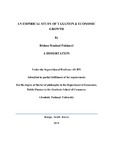Please use this identifier to cite or link to this item:
http://archive.nnl.gov.np:8080/handle/123456789/220| Title: | AN EMPIRICAL STUDY OF TAXATION & ECONOMIC GROWTH |
| Authors: | Pokharel, Bishnu Prashad |
| Keywords: | investigate the relationship between tax reforms & Economic growth Per capita income in ten countries among them the five countries |
| Issue Date: | 29-Mar-2019 |
| Abstract: | The study is to investigate the relationship between tax reforms & Economic growth Per capita income in ten countries among them the five countries are from South Asian Countries and fives are from Organization for Economic Co-operation and Development (OECD). The cross sectional panel data analysis is used here from 1990 ~ 2012. It goes further to examine whether tax reforms on the economy tax on ‘Goods and services’ & ‘Other taxes’ are should be affect in the gross domestic product per capita income . The regression analysis (OLS), the fixed effect regression model, Random Effect model, the Hausman test & Bruesch and Pegan LM are the major test. First of all, the group of model means the equations of the Regression Analysis which are denoted just numbers and another are Model 1, Model 2, and Model 3. This means that in Model one there are ten countries’ regression analysis result between dependent variables and independent variables. Different types of GDP variables are related to the independent variables and the GDP per capita income is the dependent variables. The variables all are significant in five percent level except the openness of trade. In model two, the result of Regression analysis of the five South Asian countries which are related to the South Asian Association for Regional Co operations (SAARC). Here the different kinds of tax variable Trade, Unemployment rate, FDI, Government expenditure & GDP per capita growth rate are independent variables and the GDP per capita income is dependent variable. Among the ten countries, which country’s per capita iii income is below 5000$ & the Population growth rate is very high are related to the SAARC countries. In this model the two kinds of tax variables, Government expenditure and the growth rate are significance level in 5 %. But the FDI, unemployment rate, Trade & tax revenue are not significance in 5 % level. In Model three there are five OECD countries which per capita income is very high and also called the emerging economy in the world. In this model the dependent variables is GDP per capita income and the independent variables are different types of taxes and the related variables of GDP. Here is some difference within the SAARC and whole countries result the five variables are significant in 5% level & other three variables are significance in 1% & 10%. This thesis investigates that the effects of changes in taxes & economic growth by different variables. Using annual data from 1990 to 2012 for a panel of ten economies, the results show that the effect of an increase in taxes on real GDP per capita is negative and persistent. The significant level an increase in the total tax rate measures as the total tax ratio to GDP by 1% has a long-run effect on real GDP per capita. The findings also imply that the FDI contributions & other taxes have a larger negative effect on per capita output than an increase in the tax on goods and services. After the regression analysis here I used the fixed and random effect model. In the panel data analysis the result shows that one model is best model by testing in the Hausman Test. After the HM test in all three models, the fixed effect model is appropriate for GDP per capita income growth iv dimensional equations and taxation in the economics. In the SAARC countries result and the OECD result there is a little different in same equations. When the openness of the trade in SAARC is positive to the GDP but in same result in OECD the openness is negative. Because of SAARC countries trade rate and the dependent economy to the other countries economy. The poor political situation do not completely positive followed the rules of the government & to meet sustainable growth. |
| URI: | http://103.69.125.248:8080/xmlui/handle/123456789/220 |
| Appears in Collections: | 300 Social sciences |
Files in This Item:
| File | Description | Size | Format | |
|---|---|---|---|---|
| thesis pdf .pdf | 1.18 MB | Adobe PDF |  View/Open |
Items in DSpace are protected by copyright, with all rights reserved, unless otherwise indicated.